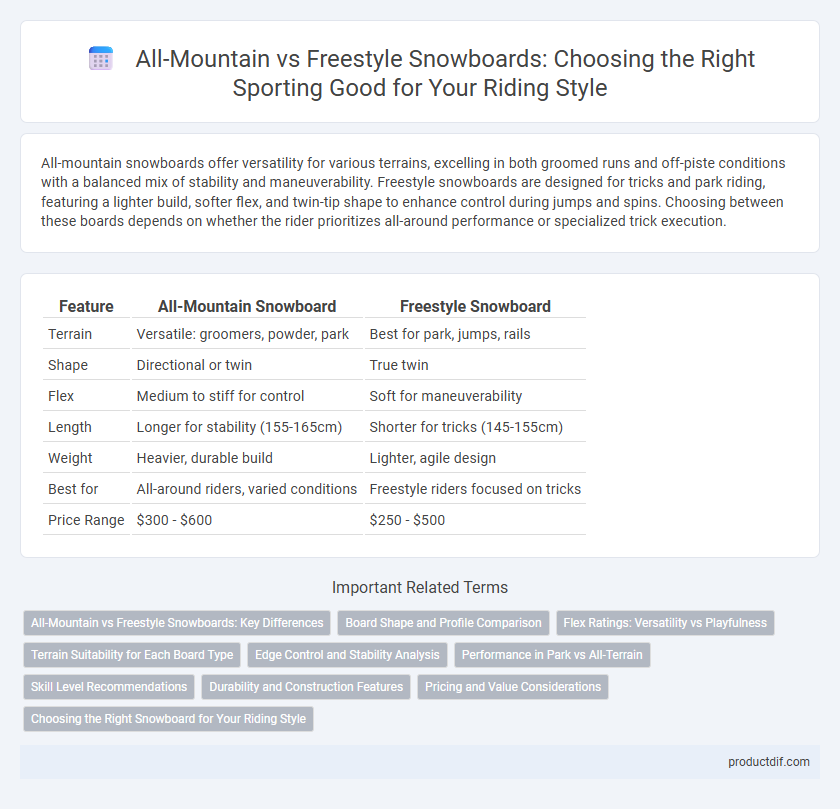All-mountain snowboards offer versatility for various terrains, excelling in both groomed runs and off-piste conditions with a balanced mix of stability and maneuverability. Freestyle snowboards are designed for tricks and park riding, featuring a lighter build, softer flex, and twin-tip shape to enhance control during jumps and spins. Choosing between these boards depends on whether the rider prioritizes all-around performance or specialized trick execution.
Table of Comparison
| Feature | All-Mountain Snowboard | Freestyle Snowboard |
|---|---|---|
| Terrain | Versatile: groomers, powder, park | Best for park, jumps, rails |
| Shape | Directional or twin | True twin |
| Flex | Medium to stiff for control | Soft for maneuverability |
| Length | Longer for stability (155-165cm) | Shorter for tricks (145-155cm) |
| Weight | Heavier, durable build | Lighter, agile design |
| Best for | All-around riders, varied conditions | Freestyle riders focused on tricks |
| Price Range | $300 - $600 | $250 - $500 |
All-Mountain vs Freestyle Snowboards: Key Differences
All-mountain snowboards offer versatility across various terrains and conditions, featuring a directional shape and medium flex for stability and control on groomed runs, powder, and small jumps. Freestyle snowboards are designed with a twin-tip shape and softer flex, optimizing maneuverability and pop for tricks, rails, and park features. The key differences lie in shape, flex, and intended use: all-mountain boards prioritize adaptability, while freestyle boards focus on agility and performance in terrain parks.
Board Shape and Profile Comparison
All-mountain snowboards typically feature a directional shape with a slightly longer nose for better stability and float in diverse conditions, while freestyle snowboards have a true twin shape allowing for symmetrical performance and easier switch riding. In terms of profile, all-mountain boards often use rocker-camber-rocker or hybrid profiles to balance float and edge control, whereas freestyle boards lean towards a flat or rocker profile to enhance maneuverability and soft landings. These differences in board shape and profile dictate their suitability for varied terrains and riding styles, making all-mountain boards versatile and freestyle boards optimal for park tricks.
Flex Ratings: Versatility vs Playfulness
All-mountain snowboards typically feature medium flex ratings, offering a balance of versatility and stability suitable for varied terrain and conditions. Freestyle snowboards have softer flex ratings, enhancing playfulness and ease of maneuverability for tricks and park riding. Choosing between the two depends on desired riding style, with all-mountain boards excelling in adaptability and freestyle boards prioritizing agility and responsiveness.
Terrain Suitability for Each Board Type
All-mountain snowboards are designed for versatility, excelling on varied terrain including groomed runs, powder, and light park features, making them ideal for riders who want to explore multiple mountain zones. Freestyle snowboards prioritize maneuverability and control on park features such as jumps, rails, and halfpipes, offering a lighter, more flexible build optimized for tricks and aerials. Terrain suitability distinctly separates these types, with all-mountain boards adapting to mixed conditions and freestyle boards engineered for performance in terrain parks.
Edge Control and Stability Analysis
All-mountain snowboards offer superior edge control and stability due to their stiffer flex and directional shape, making them ideal for varied terrain and high-speed carving. Freestyle snowboards feature a softer flex and twin tip design, which enhances maneuverability and switch riding but sacrifices some edge grip and stability on hard-packed snow. The choice between all-mountain and freestyle snowboards hinges on whether precision and control or agility and trick performance are prioritized.
Performance in Park vs All-Terrain
All-mountain snowboards excel in versatility, offering balanced performance for both park tricks and varied terrain, making them ideal for riders who want to explore the entire mountain. Freestyle snowboards prioritize lightweight construction and flexibility, enhancing maneuverability and control for jumps, rails, and technical park features. While all-mountain boards handle powder, groomers, and park equally well, freestyle boards optimize pop and responsiveness specifically for park settings.
Skill Level Recommendations
All-mountain snowboards suit intermediate to advanced riders seeking versatility on varied terrains, combining stability and control for groomed runs and off-piste conditions. Freestyle snowboards cater primarily to beginners and advanced riders focused on park features, jumps, and tricks, prioritizing flexibility and maneuverability. Skill level recommendations highlight that all-mountain boards require solid riding techniques for edge control, while freestyle boards offer a more forgiving design for those developing aerial and rail skills.
Durability and Construction Features
All-mountain snowboards feature a robust construction with reinforced edges and a thicker core designed to withstand diverse terrains, enhancing durability for varied riding conditions. Freestyle snowboards prioritize lightweight materials and a flexible build with softer cores and twin tips, trading some durability for maneuverability and easier trick execution. The all-mountain board's construction generally offers greater resilience against impacts and rough surfaces compared to the freestyle board's focus on agility and park performance.
Pricing and Value Considerations
All-mountain snowboards typically range from $300 to $600, offering versatile performance across various terrains, which provides strong value for riders seeking adaptability. Freestyle snowboards often cost between $250 and $500, focusing on lightweight design and flexibility for tricks, appealing to budget-conscious riders prioritizing park and trick features. Choosing between the two depends on budget allocation and riding style, with all-mountain boards presenting broader use and freestyle boards delivering specialized maneuverability at a lower price point.
Choosing the Right Snowboard for Your Riding Style
All-mountain snowboards offer versatility across groomed trails, powder, and park features, making them ideal for riders seeking a balanced performance in various conditions. Freestyle snowboards prioritize flexibility, lightweight design, and twin-tip shapes to enhance maneuverability and aerial tricks in terrain parks. Selecting the right snowboard depends on your primary riding style: all-mountain boards suit diverse terrains and stability, while freestyle boards excel in park features and technical trick execution.
All-mountain snowboard vs Freestyle snowboard Infographic

 productdif.com
productdif.com